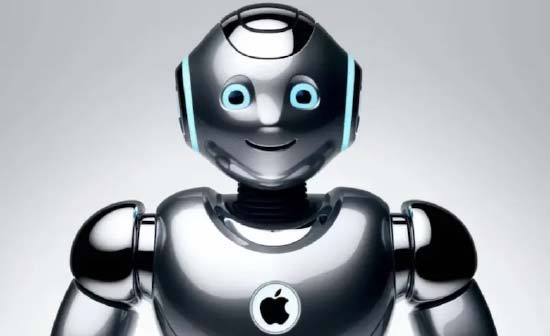Apple is planning a strong comeback in artificial intelligence with an ambitious series of new devices, including robots, a humanoid version of Siri, smart speakers with displays, and home security cameras.
According to people familiar with the matter, Apple plans to launch a tabletop robot that will serve as a virtual companion by 2027, which will be the core of the company's AI strategy. Meanwhile, a smart speaker with a display is expected to launch next year as part of Apple's plan to enter the entry-level smart home market.
Home security is seen as another area with huge growth potential. The new camera will form a core component of Apple's security system and can be used to automate home functions. According to unnamed people familiar with the matter, this strategy will help increase consumer stickiness within Apple's product ecosystem.
While Apple's transformation into AI software is still in its early stages, executives view its hardware product pipeline as a key part of its resurgence strategy, enabling it to challenge Samsung Electronics, Meta, and others in new product categories.
An Apple spokesperson declined to comment. Because these products haven't been released yet, the company's plans are still subject to change or cancellation. Many of the projects and their timelines rely on Apple's continued progress in AI-driven software.
CEO Tim Cook told employees at an all-hands meeting this month that Apple must win in AI, and he hinted at new device launches.
In addition to home devices, Apple plans to release a thinner iPhone with a more dramatic design this year. Further down the line, products include smart glasses, a foldable phone, a 20th-anniversary iPhone, and a new headset codenamed N100. The company also plans a large-screen foldable device that blends a MacBook and iPad.
After years of slowing growth in its flagship products, Apple hopes to boost sales. The company has abandoned expansion into newer areas like self-driving cars, increasing pressure to find new revenue sources. These AI initiatives will help counter claims that Apple is no longer innovating.
First reported last year, Apple was advancing a desktop robot project codenamed J595 and developing a new smart home strategy. Now, the picture of its entry into this market has become clearer, further underscoring its AI ambitions.

Robot
This desktop robot resembles an iPad mounted on a movable arm, rotating and repositioning to follow its user around the room. Like a human head, it can turn toward whoever is speaking or calling it, and even try to attract the attention of someone not facing it directly.
Apple aims to make AI "embodied" in a way that other hardware manufacturers haven't yet. The company envisions users placing it on their desks or kitchen counters to get work done, consume content, and manage their schedules.
FaceTime calling will also be a key feature of the device. During video conferences, the display can automatically rotate to focus on the position of other people in the room. Apple is testing a feature that turns the iPhone screen into a joystick, allowing users to control the robot's movement during a call to show different people or objects in the room.
But the device's biggest highlight is a new version of the Siri voice assistant that can actively participate in multi-person conversations, interact with users throughout the day, and more easily remember information.
The goal is for the device to be a person-like presence. For example, it can interject with friends while they're discussing dinner plans and recommend nearby restaurants or relevant recipes. It is also designed to engage in conversational conversations about travel planning or task execution—similar to OpenAI's voice model.
Apple plans to make Siri the core of the device's operating system and give it a visual identity to enhance its "anthropomorphism." This approach, called "Bubbles," is somewhat reminiscent of "Clippy," the virtual assistant in Microsoft Office from the 1990s.
Apple has tested making Siri look like an animated version of the Mac's Finder icon for file management (with a smiley face). However, the final image has not yet been finalized, and designers are considering making it more similar to Memoji (cartoon characters representing Apple users).
The prototype device features a landscape display of approximately 7 inches, roughly the size of an iPad mini. Its motorized arm can extend the screen about half an inch from the base in either direction.
Some people familiar with the matter said the product is internally called the "Pixar Lamp," a reference to the famous lamp in the animation studio Pixar's logo. Apple has previously publicly reported some of its research in this area: in January, the company published a paper detailing a mobile robotic lamp.
Apple's AI, hardware, software, and interface design teams are working together on the project. Some efforts are led by Kevin Lynch, who previously oversaw the development of smartwatch software and the automotive industry.
The tech giant is also developing several other robots. Some teams are exploring a mobile robot with wheels, similar to Amazon's Astro, and have held preliminary discussions on a humanoid model.
Another Apple team is developing a large robotic arm for tasks in manufacturing plants or behind the scenes of retail stores, potentially replacing some human workers in the future. This robot, codenamed T1333, is still several years away from launch.
Charismatic
Part of Apple's smart home strategy is a standalone display device planned for release by the middle of next year. Codenamed J490, this device is a simplified version of the aforementioned robot, lacking the robotic arm and conversational Siri (at least initially). However, it will still offer home device control, music playback, note-taking, web browsing, and video conferencing capabilities, and may also feature a new version of Siri's visual interface.
Both the smart display and the desktop robot will run a new operating system called Charismatic, which supports multiple users. The interface is centered around clock faces and widgets, which are typically task-specific.
The Charismatic system, previously known as Pebble and Rock in its early stages of development, combines design cues from the Apple TV and Apple Watch systems. It offers features such as a multi-user mode and customizable watch faces (such as "Snoopy").
These devices are designed for shared use: they have front-facing cameras that scan a user's face when they approach and automatically adjust the interface layout, functionality, and content to suit their preferences.
Some versions of the software system feature circular icons and a hexagonal grid layout. Apple plans to integrate a core set of apps, including Calendar, Camera, Music, Reminders, and Notes, into the devices. However, the overall interface will rely heavily on voice interaction and widgets, rather than traditional "app"-style operation.




